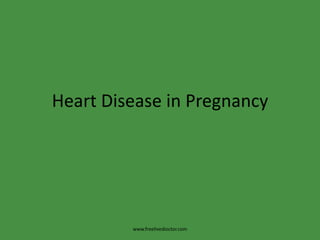
Heart Disease in Pregnancy Risks and Management
- 1. Heart Disease in Pregnancy www.freelivedioctor.com
- 2. Heart Disease in Pregnancy Incidence:1% of pregnancies. www.freelivedioctor.com
- 3. Causes 1.Rheumatic heart (75%): mitral valve affection is the commonest followed by aortic valve then both or others. 2.Congenital heart diseases (10%): a.Acyanotic(left to right shunt): more common, includes septal defects and patent ductusarteriosus. b. Cyanotic (right to left shunt): e.g. Fallot’stetralogy and Eisenmenger’s syndrome which is more dangerous carries a maternal mortality rate exceeding 25%. 3. Others (5%): e.g. ischaemic heart disease, arrhythmias and cardiomyopathy. www.freelivedioctor.com
- 4. Diagnosis History of: > rheumatic fever, > heart lesion, > dyspnoea, > paroxysmal nocturnal dyspnoea, > orthopnoea, > haemoptysis, > prophylaxis with long acting penicillin. www.freelivedioctor.com
- 5. Diagnosis Examination may reveal: > murmur, > accentuated heart sound, > arrhythmia, > central cyanosis, > displaced apex beat, > manifestations of left side heart failure e.g. gallop rhythm, crepitations over lung bases and pleural effusion. > manifestations of right side heart failure e.g. congested neck veins, enlarged tender liver, ascitis and oedema lower limbs. www.freelivedioctor.com
- 6. Investigations >Chest X-ray: may show cardiac enlargement, pulmonary congestion or pleural effusion. >Electrocardiography (ECG). > Echo cardiography: shows cardiac structure and function. www.freelivedioctor.com
- 7. Functional classification According to New York Heart Association (1964); Class I: No discomfort (i.e. dyspnoea, palpitation or anginal pain) on ordinary activity. Class II: Discomfort on ordinary activity. Class III: Discomfort on less than ordinary activity. Class IV: Dyspnoea at rest. Patient is decompensated. www.freelivedioctor.com
- 8. Effect of Pregnancy on Heart Disease Heart failure: Subacute bacterial endocarditis: may develop in the puerperium. www.freelivedioctor.com
- 9. Heart failure: > During pregnancy, heart failure can occur at any time but the maximum incidence is between 32 and 34 weeks when the blood volume and cardiac output are in their peaks. After that they have a plateau level up to full term. > During the 2nd stage, heart failure may occur due to stress on the heart. > After delivery, failure may occur due to loading of the circulation by the blood from the placental sinuses after retraction of the uterus. www.freelivedioctor.com
- 10. Effect of Heart Disease on Pregnancy > Abortion. > Intrauterine growth retardation. > Still birth. > Premature labour. www.freelivedioctor.com
- 11. Management General management: > More frequent antenatal visits. > More rest. > Diet is directed to restrict weight gain and prevent anaemia as it increases cardiac strain. > Infection should be avoided and properly treated. > Hospitalisation: if signs of decompensation occur, the earliest evidence is tachycardia exceeding 100 beats/ minute and crepitations at the lung bases. Rest in a hospital is desirable in the last 2 weeks of pregnancy. www.freelivedioctor.com
- 12. Management Specific management: Medical treatment: Surgical treatment: www.freelivedioctor.com
- 13. Medical treatment: a. Digoxin: is indicated in atrial fibrillation to slow the ventricular response and in acute heart failure to increase myocardial contractility. b. Diuretics are used in acute and chronic heart failure with potassium supplements in prolonged therapy. www.freelivedioctor.com
- 14. Medical treatment: c. Beta-adrenergic blockers: as propranolol may be indicated for arrhythmia associated with ischaemic heart disease d. Aminophylline: relieves bronchospasm. e. Heparin: is indicated in patients with artificial valves or atrial fibrillation. www.freelivedioctor.com
- 15. Medical treatment: f .N.B. Acute pulmonary oedema is urgently treated by: > Morphine 15 mg IV, to allay anxiety and reduce venous return. > Oxygen. >Digoxin1 mg IV, except in severe mitral stenosis as the increase in right heart output cannot be handled by the mitral valve. >Aminophylline 250 mg IV. > Venesection, removing 500 ml blood rapidly may be indicated in severe cases. www.freelivedioctor.com
- 16. Surgical treatment: >Therapeutic abortion: should be considered in class III and IV if the patient is seen early in pregnancy. > Cardiac surgery: It may be an alternative to therapeutic abortion. The principal indication is recurrent pulmonary oedema with mitral stenosis and heart failure not responding to medical treatment. There is no increased risk to the mother or the foetus in closed cardiac surgery e.g. mitral valvotomy but there is higher incidence of foetal loss with open surgery. www.freelivedioctor.com
- 17. Management of labour > There is no indication to induce labour because of cardiac disease. > If induction of labour is indicated for an obstetric cause e.g. antepartumhaemorrhage a low amniotomy + oxytocin in a concentrated glucose solution is the best method. This minimises the incidence of infection and pulmonary oedema. > Induction of labour never to be undertaken in patient with acute heart failure. www.freelivedioctor.com
- 18. Management of labour > Vaginal delivery is preferable to caesarean section but should be an easy and not a prolonged one. > There is no place for " trial of labour" in cardiac patients. > Bed rest in semi-sitting position. > Oxygen mask or ventilation if heart failure or cyanosis develop. www.freelivedioctor.com
- 19. Management of labour > Adequate analgesia pethidine or morphine can be used. Epidural anaesthesia is preferable as it abolishes the bearing down desire so decreases the effort load. > Shorten the second stage by forceps or ventouse. > Ergometrine is better avoided as it causes sudden load of the circulation with blood from the uterus leading to acute heart failure. Oxytocin can be used instead. www.freelivedioctor.com
- 20. Management of labour > Prophylactic antibiotic is essential to guard against subacute bacterial endocarditis. > Postpartum observation for 48 hours is essential as the risk of heart failure is high in this period. Although bed rest is essential, early ambulation is desirable to avoid thromboembolism. www.freelivedioctor.com
- 21. Management of labour > Breast feeding is allowed unless there is heart failure. Oestrogens should not be used to suppress lactation and bromocriptine or lisuride can be used. > Sterilisation may be advised if decompensation occurred in this pregnancy. www.freelivedioctor.com